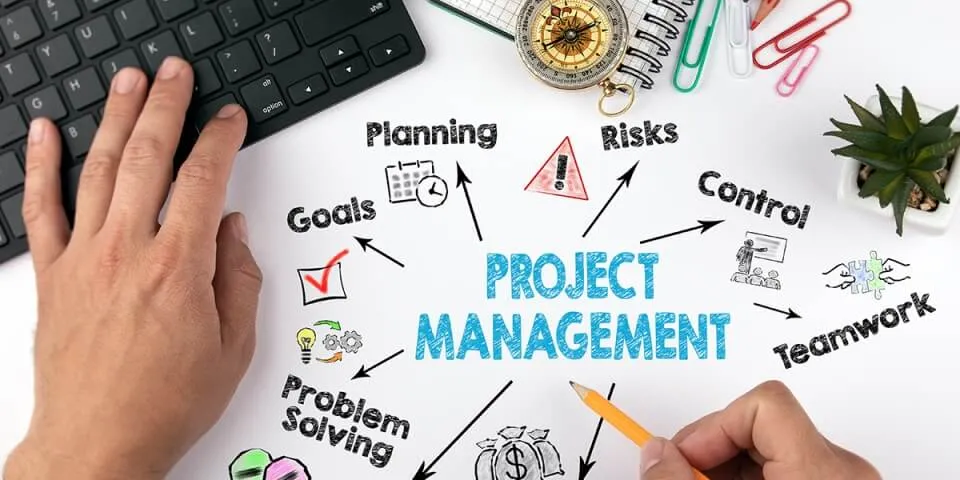What is project management? It’s the art of coordinating processes, tools, team members, and skills to deliver projects that surpass your goals.
Imagine you and your team are preparing to tackle a major project. It’s like setting up an intricate line of dominoes—thrilling when it all falls perfectly into place, but frustrating if even one piece is misaligned.
Projects can be both daunting and exciting, and it’s tempting to dive in immediately. Do you just cross your fingers and hope everything works out? Or maybe wish for a magical genie to appear and lend a hand? While that would be amazing, the real key to success for your complex projects is effective project management.
What is project management, and why is it important?
Project management is the practice of coordinating processes, tools, team members, and skills to deliver projects that meet goals and satisfy requirements. It empowers your team to complete projects by rallying them around clear objectives, increasing transparency and visibility, streamlining communication, and establishing the project scope. Need more convincing? Consider that Project overruns are frighteningly common. In the IT industry alone, McKinsey found that on average, large IT projects run 45% over budget and 7% over time.
Project management methodologies
Have you heard that old adage “more than one way to cook an egg”? There’s no one strategy for completing a kick-ass project. That’s where a project management methodology comes into play. It’s a set of rules, principles, and processes for managing a project.
Methodologies might sound formal, but you have some room to innovate here! It’s important to note that many teams and companies use a combination, rather than relying exclusively on one. Regardless of which approach you choose, it should help promote a strong culture of transparency.
1. Waterfall project management
When you think of traditional, sequential project management, you’re picturing waterfall project management. With this method, you break your project into different phases. When one phase ends, the next one begins — there’s no overlap between them.
When to use: For long projects that require a single timeline and a sequential order.
Commonly used in: Construction. Building a house or structure requires a successive order. You can’t put on a roof before you’ve poured a foundation, for example.
2. Agile project management
Agile project management is an iterative approach and is much more flexible than waterfall project management. It’s a DevOps best practice that breaks projects into chunks that are tackled in short bursts (called sprints). After each sprint, your team reevaluates the work you’re doing to make any necessary changes and ensure you’re staying on target.
Scrum
Scrum project management is one of the most popular Agile methodologies used by project managers. Like Agile, scrum is centered around continuous improvement. You can use a framework like scrum to help you start thinking in a more Agile way and practice building Agile principles into your everyday communication and work.
When to use: For projects that aren’t yet well-defined and require a lot of adaptability.
Commonly used in: Software development. This profession pioneered agile, and this approach allows developers to build higher-quality software because they’re able to test and review at regular intervals.
3. Lean project management
If you’ve heard of lean manufacturing, those same principles apply to lean project management. The goal of this methodology is to increase output and value while reducing waste. To use it, you’ll need to map a value stream, which is the sequence of project activities. Then, you take a magnifying glass to that stream to identify and eliminate work that doesn’t add value. This means your project process will be as streamlined, optimized, and efficient as possible.
Kanban
Kanban is a specific implementation of Lean project management. Project tasks are represented visually on a Kanban board, allowing team members to see the state of every piece of work at any time.
When to use: For projects that need to be delivered quickly.
Commonly used in: Manufacturing. When you’re producing physical goods, you want as little waste as possible to minimize spend and maximize profit. That’s why this approach is popular in manufacturing, especially in the automotive industry.
The 5 stages of the project management process
Imagine that you’re starting a project from the very beginning. Project management doesn’t come into play only when you actually start checking off tasks — you need to lay the groundwork first.
With that in mind, the Project Management Institute (PMI) established five distinct stages of project management.
Stage #1: Initiating
Think the first step of the project management process is planning? Not quite. Before you can map out a strategy for your project, you need to get stakeholder buy-in. This is where a project charter comes in to outline the business objective of your project for approval. We recommend using a project poster instead, as a more digestible format that’s faster and easier to read. In this stage, you should answer questions like:
- What’s the business case for this project? Our strategic plan template can help!
- Is this project feasible?
- Should we pursue this project?
To put it simply, in this stage you’re trying to decide if this project is even worth tackling before you invest too much elbow grease.
A great way to help facilitate this discussion is a premortem, a thought exercise in which you imagine what could go wrong and decide how to prevent it.
Stage #2: Planning
If you decide to move forward, you’ll next head into the planning stage. This is where you’ll develop a detailed project plan that your entire team will follow––and thank you for! Planning is essential for avoiding scope creep. Our to-do list template can help! . Questions to answer in this stage include:
- What is the goal of this project?
- What are the key performance indicators (KPIs)?
- What is the scope?
- What is the budget?
- What are the risks?
- What team members are involved?
- What tasks are involved?
- What milestones need to be met?
This step is to ensure you and your team all have shared expectations before you get started. If you think you’re getting too caught up in the minutiae, you aren’t. And strategic planning frameworks can help!
Stage #3: Executing
Grab your coffee and get your power cable, because it’s go-time. This is where you and your team will roll up your sleeves and start conquering project tasks with your project plan as your guide. In the execution stage, you’ll need to:
- Allocate necessary resources
- Ensure assignees carry out their tasks
- Host status meetings
- Set up tracking systems
The bulk of the work happens in this stage, and it’s also where you’ll start to see your project really coming together. See? All that planning was worth it.
Stage #4: Monitoring
Just because you have a project plan doesn’t mean things will run smoothly on their own. It’s like setting a budget for yourself — having the budget doesn’t do anything if you don’t keep a close eye on how you’re managing your money.
That’s why you need to monitor project progress to ensure things stay on track. You should evaluate your project against the KPIs you established in the planning stage.
What should you do if your project feels like it’s strayed from the path or fallen prey to scope creep? Take a moment to reevaluate. You can decide if you need to realign things, or if your original plan needs to shift. That’s the great thing about monitoring — you have regular checkpoints to course correct.
Stage #5: Closing
The closing stage is about wrapping up loose ends. This includes:
- Hosting a postmortem or retrospective to evaluate the project
- Preparing a final project report
- Collecting and storing necessary project documentation somewhere safe. A collaborative documentation space like Confluence is great for this, by the way.
Not only does this give your team the chance to officially wash their hands of the project, but it also makes it easier to refer back to it when necessary.
7 Tips for successful project management
Even if you follow all of the above steps, effective project management isn’t a set-and-forget scenario. There are a few other best practices you’ll want to implement to help your project run as smoothly as possible.
Host a project kickoff meeting
Your project kickoff meeting is when you’ll establish goals, break down your timeline, and generally get everybody on the same page about your project. Our team meeting agenda template can help!
Regardless of how excited your team is to get to work, don’t skip this sitdown. You’ll proactively clear up confusion and rally your team around a shared goal.
Be mindful of task and resource dependencies
Remember when we talked about projects that feel like a string of teetering dominoes? That’s especially true for large, cross-functional projects. Maybe Daisy can’t start creating graphics until Joel has drafted the content (that’s a task dependency). Or maybe Choua can’t use a piece of software while Derek is using the shared license (that’s a resource dependency).
Your project tasks don’t happen in a vacuum, so it’s important that you account for these dependencies using a Gantt chart template.
When all of your tasks and resources are connected, you need to understand how they fit together, or you run the risk of watching in horror as your whole line of dominoes comes toppling down.
Identify your critical path
Identifying your critical path is a great way to prevent schedule overruns. While it might sound like something out of an action movie, your critical path is just your longest string of dependent project activities. If you hit a snag or delay on that path, you know the whole project is at risk of coming in late.
Finding your critical path allows you to know where you have some wiggle room in your schedule, and where you need to stick as close to your timeline as possible.
Be realistic with your timeline
It’s common to underestimate the time it takes us to complete tasks, and it can be a real detriment to your project timeline.
Keep yourself in check by referring back to timelines for previous projects. Consult your time-tracking software (if you have it) to see how long typical tasks take, and ask your team to gut check their schedules.
Use project management software
If your team members need to dig through endless email threads or folders to find what they need, your project is bound to drag behind.
That’s why it’s helpful to use project management software to store your documentation and organize your project in a knowledge management software. It increases visibility into all project steps and tasks, centralizes communication, and gives your project team one single source of truth.
Establish clear roles and responsibilities
To get the best output from your team, people need to know exactly why they’re involved. What is their role and what are they expected to contribute?
Not only does this instill a sense of purpose and accountability in your project team members, but it also prevents them from stepping on each other’s toes and allows you to play to everyone’s strengths. A RACI framework is a popular way to assign roles and responsibilities. The acronym RACI stands for responsible, accountable, consulted, and informed. Confluence slightly tweaks this framework, calling it DACI, with “D” standing for “driver.”
Managing a project can be stressful, and you don’t have to do it all alone. Your team will have a lot of great insight into your project plan, including if your timeline is realistic or if you’re forgetting about dependencies. Team brainstorming is a great way to share and hash out ideas. Here are some tips for running an effective brainstorming session.
Even if you’re part of a hybrid or remote team, resist the temptation to plan projects in isolation. Involve your team to hash out a more reasonable plan and boost their sense of ownership over the project. Our brainstorming template can help!
Key members of a project team
Every project must begin by identifying roles and responsibilities. Knowing your role upfront sets everyone up for success in staying on track to meet project deadlines. Potential project roles include:
- Project manager: Person who oversees the entire project and is responsible for the project’s success.
- Project sponsor: Senior manager who champions the project and works closely with the project manager.
- Team member: People who actively work on the project tasks.
- Supplier: People who provide goods or services for a project.
- Stakeholder: People who have an interest in the project. These can be broken into:
-
- Primary stakeholders: People who actually do the work and are actively involved in the project.
- Secondary stakeholders: People who might come to meetings and play a small part but aren’t key decision-makers in the project.
- Interested stakeholders: People who are in the loop on the project but don’t play an active part or have a lot of influence.
- Client: Person who receives the final project, if it’s a client-facing project rather than an internal one.












About The Author
InnoValeur
Conseil, intégration, et support sur SAP